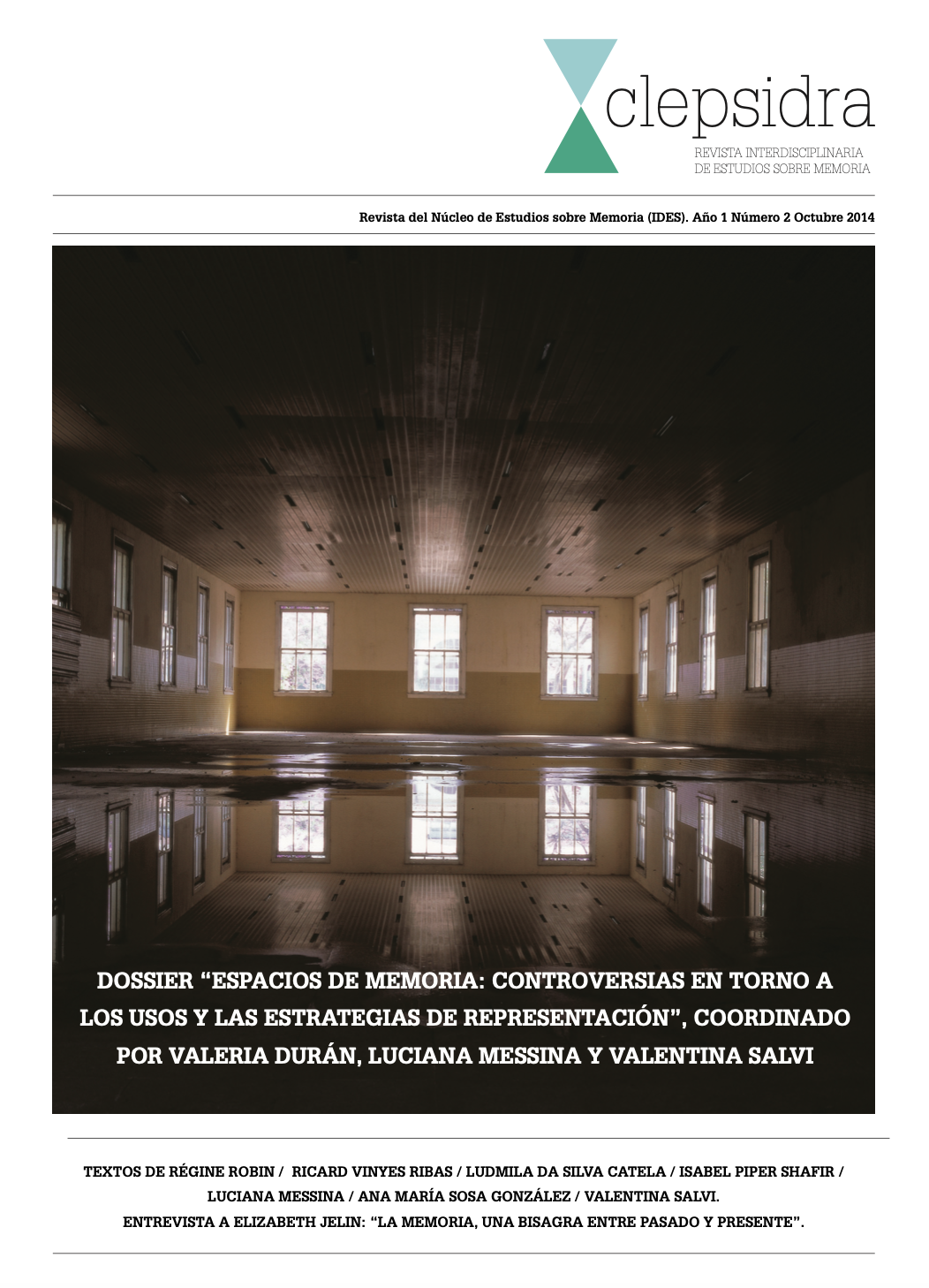Sites of Memory and Exchanges of Places
Keywords:
Holocaust; Mundialization; Sites of Memory; Transmission.Abstract
This article focuses on the exchange of places between the authentic sites where extermination itself happened during the Holocaust and the development, all over the world, of new sites to commemorate the memory of the victims. As well as, it looks into a paradox that occurs between the diffi- culties for transmission the event and the excess of insti- tutions and memorials. Finally, it examines if art, cinema, literature, the contra-monumento and happening are able response to a world in which the memorial will be replaced by a posmemoria
Downloads
References
Bratu Hansen, Miriam (1997). “Schindler’s List is not Shoah. Second Commandment, Popular Modernism and public Memory”. En: Loshitzky, Yosefa (Ed.); Spielberg’s Holocaust. Critical perspective on Schindler’s List. Bloomington: Indiana University Press.
Cole, Tim (1999). Images of the Holocaust. The Myth of the “Shoah Business”. Londres: Duckworth.
Derrida, Jacques (1993). Les Spectres de Marx. Paris: Galilée.
Diekmann, Irene y Schoeps, Julius H. (Ed.) (2002). Das Wilkomirski-Syndrom. Zurich: Pendo.
Flanzbaum, Hilene (Ed.) (1999). The americanization of the Holocaust. Baltimore: The Johns Hopkins University Press.
Forges, Jean-François (1997). Éduquer contre Auschwitz. Histoire et mémoire. Paris: ESF Pédagogies.
Ganzfried, Daniel (2002). Alias Wilkomirski. Die Holocaust-Travestie. Berlin: JVB.
Gourevitch, Philip (1993). “Behold New Behemoth. The Holocaust Memorial Museum: one more American Theme Park”. En: Harper’s Magazine, julio de 1993.
Gourevitch, Philip (1999). “The Memory Thief”. En: The New Yorker, 4 de junio: pp. 51-52.
Gruber, Ruth Ellen (2002). Virtually Jewish. Reinventing jewish Culture in Europe. Berkeley: University of California Press.
Hirsch, Marianne (1997). Family Frames. Photography narrative and Postmemory. Cambridge: Harvard University Press.
Koselleck, Reinhart (2001). “Posfacio al libro de Charlotte Beradt”. En: Rêver sous le IIIe Reich, Payot (edición alemana de 1981).
La Capra, Dominick (1998). History and Memory after Auschwitz. New York: Cornell University Press.
Lappin, Elena (1999). L'homme qui avait deux têtes. Paris: Les éditions de l'Olivier.
Linenthal, Edward T. (1995). Preserving Memory. The Struggle to create Holocaust Museum. New York: Viking Press.
Mächler, Stefan (2000). Der Fall Wilkomirski. Über die Wahrheit einer Biographie. Zurich/ Munich: Pendo.
Maier, Charles (1993). “A Surfeit of Memory? Reflections on History, Melancoly and Denial”. En: History and Memory, vol. 5, nro. 2: pp. 136-152.
Nora, Pierre (1997). Les lieux de Mémoire. Volumen 1. Paris: Gallimard. Nouvelle édition. [Trad.: Nora, Pierre. “Entre memoria e historia. La problemática de los lugares”, en Pierre Nora (2008), Les lieux de mémoire, Montevideo: Trilce, 2008].
Novick, Peter (2001). L’Holocauste dans la vie américaine. París: Gallimard.
Redeker, Robert (1993). “La catastrophe du révisionnisme”. En: Les Temps modernes, noviembre: pp. 1-6.
Robin, Régine (1998). “Traumatisme et transmission”. En: Jean-François Chiantaretto (Dir.) Ecriture de soi et trauma. Paris: Anthropos. Pp. 115-131.
Robin, Régine (2001). Berlin Chantiers. Essai sur les passés fragiles. Paris: Stock.
Robin, Régine (2003). La mémoire saturée. Paris: Stock.
Shnur, Emma (1997). “Pédagogiser la Shoah”. En: Le Débat, nro. 96, septiembre-octubre de 1997: pp. 122-140.
Szurek, Jean-Charles (1990). “Le camp-musée de’Auschwitz”. En: Alain Brossat, Sonia Combe, Jean-Yves Potel y Jean-Charles Szurek (Dirs.); A l’est, la mémoire retrouvée. Paris: La découverte.
Terray, Emmanuel (1996). Ombres berlinoises. Voyage dans une autre Allemagne. Paris: Odile Jacob.
Wiedmer, Caroline (1999). The Claims of Memory. New York: Cornell University Press.
Wieviorka, Annette (2005). Auschwitz, 60 ans après. Paris: Éditions Robert Laffont.
Wieviorka, Annette y Niborski, Itzhrok (1983). Les livres du souvenir: Mémoriaux juifs de Pologne. Paris: Gallimard.
Young, James E. (1992). “The Counter-Monument: Memory against itself in Germany Today”. En: Critical Inquiry, 18: pp. 267-296.
Young, James E. (1993a). The Texture of Memory: Holocaust Memorials and Meaning. Londres: Yale University Press/New Haven.
Young, James E. (1993b). “Écrire le monument : site, mémoire, critique”. En: Annales ESC, nro. 3, mayo-junio: pp. 729-743.
Young, James E. (1997). “Germany's Memorial Question. Counter-Memory and the end of the Monument”. En: The South Atlantic Quaterly, vol. 96, nro. 4: pp. 853-880.
Young, James E. (2000). At Memory's Edge. After-Images of the Holocaust in Contemporary Art and Architecture. Yale University Press.
Zajde, Nathalie (1993). Souffle sur tous ces morts et qu'ils vivent. La transmission du traumatisme chez les enfants des survivants de l'extermination nazie. Paris: La pensée sauvage.
Downloads
Published
How to Cite
Issue
Section
License

This work is licensed under a Creative Commons Attribution-NonCommercial-ShareAlike 4.0 International License.
La revista Clepsidra. Revista Interdisciplinaria de Estudios sobre Memoria es una publicación en Acceso Abierto y no cobra dinero a los autores y autoras por publicar (APC) como tampoco a los lectores por acceder al contenido publicado. En este marco, la publicación utiliza las licencias Creative Commons, específicamente Atribución-NoComercial-CompartirIgual 4.0 Internacional (CC BY-NC-SA 4.0). Por esta razón, cuando un manuscrito es aprobado para la publicación, los autores y autoras retienen los derechos de autor sobre su trabajo, pero autorizan a copiar, distribuir, hacer obras derivadas del trabajo original, a condición de atribuir siempre la autoría del trabajo en la forma especificada por el autor o licenciante de la obra. Esta licencia no permite, sin embargo, utilizar la obra ni sus posibles trabajos derivados con fines comerciales.
Por su parte los autores y autoras conservan los derechos sobre el trabajo y garantizan el carácter de inédito y original. También, los autores y autoras ceden a Clepsidra… el derecho, no exclusivo, de publicarlo de manera electrónica. Por lo tanto, los autores y autoras podrán disponer de las versiones finales y difundirlas en repositorios institucionales, temáticos, páginas web personales o cualquier otro uso pertinente, siempre que se mencione la fuente original de publicación.













